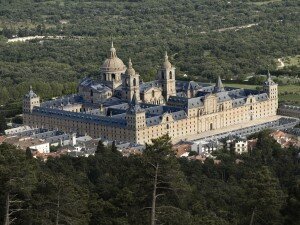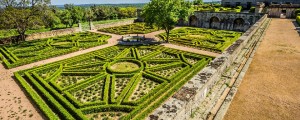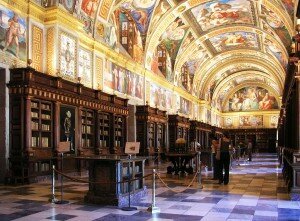Seniors Visit El Escorial
 For some reason, this senior put El Escorial on the desktop screen of my computer. So one day I took a closer look at the site and was I ever impressed with what I saw.
For some reason, this senior put El Escorial on the desktop screen of my computer. So one day I took a closer look at the site and was I ever impressed with what I saw.
It was something very special. Do you have your coffee? We’re going to Spain this morning.
I discovered that the Royal Site of San Lorenzo de El Escorial, commonly known as El Escorial, is a historical residence of the King of Spain, in the town of San Lorenzo de El Escorial, some 35 miles northwest of the capital, Madrid. The Escorial is a UNESCO World Heritage Site and one of Spain’s most visited landmarks.
The building is the most important architectural monument of the Spanish Renaissance.
Construction of El Escorial began in 1563 and ended in 1584. The Escurial Monastery stands in an exceptionally beautiful site in Castile.
Seniors Find a Monastery, A Church And A Royal Palace
Its austere architecture, a break with previous styles, had a considerable influence on Spanish architecture for more than half a century.
It was the retreat of a mystic king and became, in the last years of Philip II’s reign, the centre of the greatest political power of the time.
Within the monastery’s massive volume, there is an ensemble of different buildings: the monastery, the church, the royal palace, the school, the seminary, and the royal library, brilliantly organized around eleven main courtyards and three service courtyards.
It is said that the design is similar to that of the grill, the instrument used for St Lawrence’s martyrdom.
Its accessibility and connection to Madrid have turned it into a tourist destination for the Madrid residents as well as senior visitors that feel attracted by the patrimonial, cultural and natural attractions of the city.
UNESCO World Heritage Site
FeelMadrid.com notes that El Escorial is “Simplicity in the construction, severity in the whole, nobility without arrogance, majesty without ostentation.” That statement says it all to me from what I have observed writing this blog.
In the foothills of the Sierra de Guadarrama, it was built as a monument to commemorate the Spanish victory over the French in the battle of Saint Quentin on 10 August 1557 (feast day of St. Lawrence).
El Escorial Monastery was the largest building in the world (about 675 by 528 feet/206 by 161 meters), for a period of time, a great rectangle of three parts, the center being occupied by the church.
So on your visit to Spain and Madrid in particular, senior travelers, plan to spend some times at El Escorial. Bring along some extra memory chips for your camera, it is that kind of structure. Enjoy. -jeb





